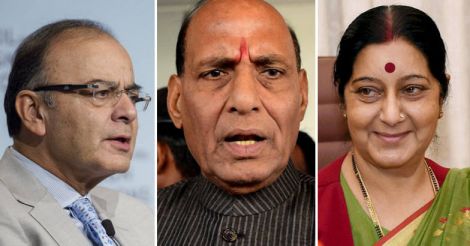When Narendra Modi arrived on the national scene in 2013, three leaders dominated the BJP: Rajnath Singh as the party president, Sushma Swaraj and Arun Jaitley as opposition leaders in the Lok Sabha and Rajya Sabha, respectively, were deciding the party's strategy.
By the time Modi campaigned and took the party to victory in the 2014 Lok Sabha elections, Swaraj had withdrawn herself into a shell. At one time considered to the BJP's shadow prime minister, Swaraj was content to have been given the important external affairs ministry.
The signature of Arun Jaitley was written all over the first cabinet of Modi and the inputs from Rajnath Singh were equally evident. Both leaders were invited to join the government, and Jaitley suggested his proteges in the party for key economy and infrastructure portfolios.
Though the BJP had an absolute majority in the Lok Sabha, Jaitley as leader in Rajya Sabha pushed the cause of Prakash Javadekar, Dharmendra Pradhan and Piyush Goyal. He also pitched hard the case of Nirmala Sitharaman, a popular party spokesperson even though she was not a member of Parliament.
Singh advised on regional and communal balance by pushing the cause of members from Uttar Pradesh, Bihar and the eastern states. Jaitley again had a say a few months later when Modi went for a minor expansion and shuffle of the ministry.
Modi brought in Suresh Prabhu from the Shiv Sena and Birendra Singh who had defected from Congress. While Birendra Singh had weakened the Congress in the Haryana assembly elections, Prabhu's dynamism had enthused Modi. Amit Shah as party president had little role to play in that expansion.
But the reshuffle done last week has been projected as a combined exercise by Modi and Shah, with Jaitley and Rajnath Singh playing second fiddle. It was not the prime minister who called each of the new appointees but Shah.
Amit Shah had set up his own research department and had intensive discussions on the expansion, and he was given the job of asking the new appointees to reach Delhi. The day before the oath-taking ceremony, the prospective ministers all drove to Shah's residence for a meeting, where Jaitley was also present. Modi clearly wanted to send a message that the party president was the No. 2 man, and that was evident from the seating arrangement at the Rashtrapati Bhavan too.
But the way the prime minister dramatically withdrew and re-allotted key portfolios like human resource development, rural development, law and justice, telecommunications, etc., showed that Modi himself had reviewed and found senior ministers wanting in their performance. Junior ministers like Rao Inderjit Singh and Jayant Sinha who had talked out of turn were shifted out of the crucial defense and finance ministries. Modi also did a balancing act by recognizing those who were close to L K Advani and Sushma Swaraj, sending a message to the party.

























 A combo image of Arun Jaitley, Sushma Swaraj and Rajnath Singh
A combo image of Arun Jaitley, Sushma Swaraj and Rajnath Singh